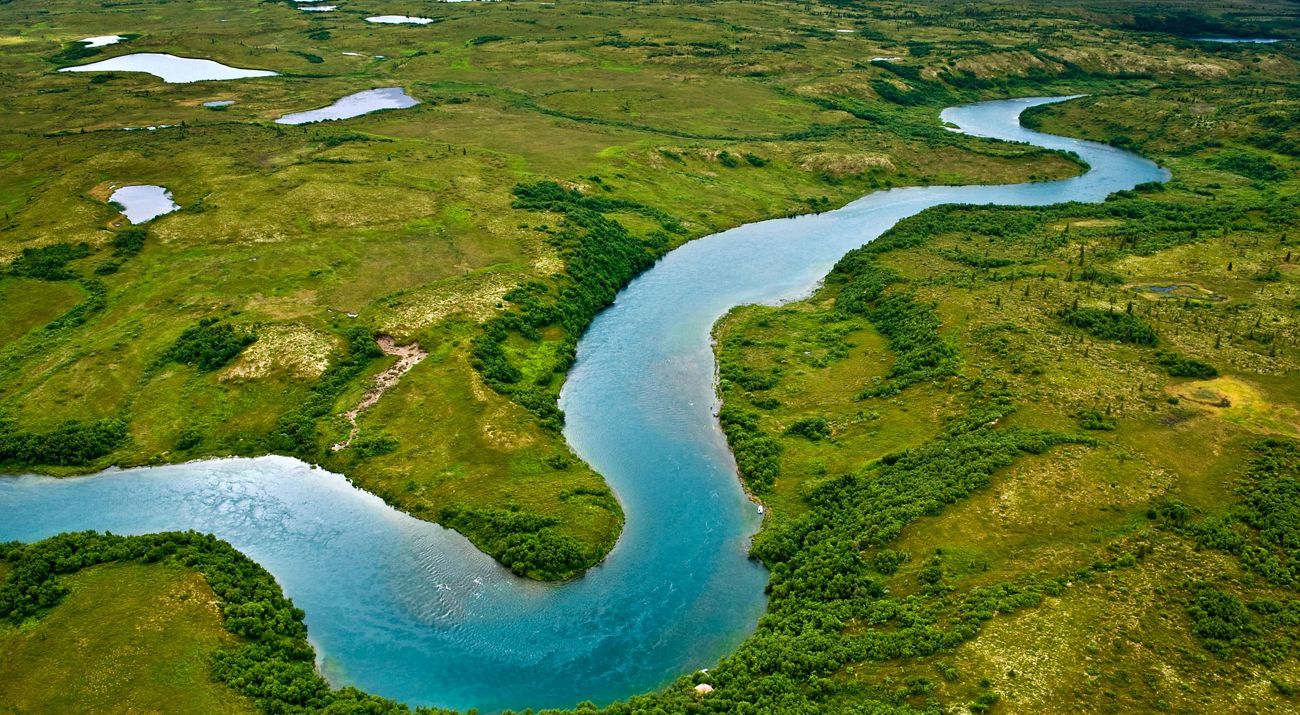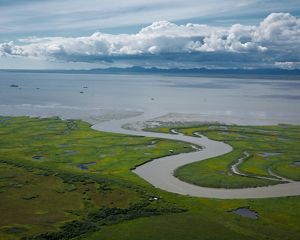Science to Guide Conservation in Bristol Bay
This globally important migration is in peril. Learn how we are taking a stand.
The migration of wild salmon is one of nature’s most wondrous journeys. Through the wild salmon’s remarkable cycle of life, in a single lifetime, a wild Pacific salmon will migrate from their place of birth—in a freshwater stream or lake—to the Pacific Ocean—and back again. This migration may span many hundreds of river miles, with an ocean phase of their life cycle leading them far into the Pacific and lasting several years.
As a cycle of life, wild salmon are entirely reliant on healthy lands and waters—cold, clean and abundant water in free-flowing rivers amid forests and, in Alaska, vast tundra uplands. For wild salmon, the health of the land surrounding lakes and rivers is as important as the health of their waters.
One region of southwest Alaska is known as Bristol Bay. It’s a region the size of Ohio yet with a population of just 7,000 people. This nearly pristine region produces more wild salmon than anywhere else on Earth. Bristol Bay’s annual salmon migration of returning adult salmon brings a natural spectacle that attracts a wild range of wildlife—think bears, whales and eagles. It also sustains a traditional way of life dating back millennia as well as the region’s $2.2 billion sustainable fisheries industry.
Why here? It’s the wealth of healthy streams and rivers, wetlands and lakes. This mix of pristine habitat creates a diverse genetic portfolio of several hundred discrete sockeye salmon populations—and this diversity is key to productivity and long-term sustainability. Every year, it adds up to an average return of about 40 million sockeye salmon—truly the Earth’s last best salmon runs.
Bristol Bay’s portfolio of genetic diversity—much like a diverse investment portfolio—contributes to a more resilient salmon system and bolsters local fishery-dependent economies. Wiping out or harming any of these discrete salmon populations puts the productivity of the larger Bristol Bay salmon system at risk over time.
Despite Bristol Bay’s astonishing natural wealth—a standout even in Alaska—its globally important salmon runs are in danger. The proposed Pebble mine would straddle the pristine headwaters of the Nushagak River and Kvichak River, spawning grounds for about half of Bristol Bay’s salmon. The proposed mine would be one of the largest open-pit mines in the world, extracting billions of tons of copper, gold, and molybdenum ore to the irreparable harm of the surrounding lands, waters and way of life.
Explore nature and life in Bristol Bay.
Our last, best chance to save Bristol Bay is now. To protect this globally significant diversity of wild salmon populations and the people who depend on them, TNC is working with a broad coalition of partners to eliminate the threat of the proposed Pebble mine and the unacceptable levels of risk it would bring to an ecologically rich area. TNC and its regional partners stand committed to supporting a regional vision for a sustainable, equitable and thriving future for local communities.
Join us to speak out in opposition of Pebble Mine. Contact your federal representatives.
Leading with Science
The Nature Conservancy has invested in a science-led process to assess the risk of developing the proposed Pebble mine in the headwaters of two of the planet's most productive wild salmon rivers. This research led to an influential 2010 resolution on large-scale mining in Bristol Bay which was authored by the Board of Trustees of The Nature Conservancy in Alaska. The proposed Pebble mine does not meet the standard identified in this resolution, and for this reason TNC stands opposed to the project.
Since the Pebble mine was proposed for the headwaters of the Nushagak and Kvichak rivers in the early 2000s, The Nature Conservancy, tribal environment programs, and other research organizations have compiled thorough inventories of the region’s salmon streams, hydrology, traditional use areas, water quality and more.
This includes our 2019 assessment of direct loss of salmon streams, tributaries and wetlands under the proposed mine plan contributed a thorough level of review. This assessment compared the thresholds of unacceptable adverse effects to salmon streams as outlined in the EPA's proposed determination to the Clean Water Act, Section 404(c).
See our assessment of the risk of tailings dam failure in Bristol Bay salmon headwaters.
Sustainable Future
A diverse coalition of local and regional voices has united in opposition to the proposed Pebble mine. The commercial fishing industry, local tribes, community organizations, local government and conservation organizations have all opposed the mine. Meanwhile, TNC joins a growing chorus for a regional vision for a sustainable, equitable and thriving future for local communities.
TNC is working with a broad coalition to oppose the development of Pebble mine and its resulting risks to salmon, their habitat and the people and economies that depend on them.
Ecological Risk Assessment
- SYNTHESIS — A Preliminary Framework for Assessment of Ecological Risk to Wild Salmon from Large-scale Mining in Bristol Bay, Alaska. Source: The Nature Conservancy (.pdf)
- An Assessment of Ecological Risk to Wild Salmon Systems from Large-scale Mining in the Nushagak and Kvichak Watersheds of the Bristol Bay Basin. Source: The Nature Conservancy (.pdf)
Ecological Risk Assessment—Literature Review
- A Literature Review of Effects of Ammonia on Fish. Source: The Nature Conservancy (.pdf)
- A Literature Review of Effects of Cadmium on Fish. Source: The Nature Conservancy (.pdf)
- Annotated Bibliography: Effects of Cadmium on Fish. Source: The Nature Conservancy (.pdf)
- Annotated Bibliography: Effects of Copper on Fish. Source: The Nature Conservancy (.pdf)
- Annotated Bibliography: Effects of Zinc on Fish. Source: The Nature Conservancy (.pdf)
RISKS OF TAILINGS DAM FAILURE AT THE PROPOSED PEBBLE MINE
COMPARISON OF SECTION 404(C) OF THE CLEAN WATER ACT AND THE 2018 MINE PROPOSAL’S LOSS TO SALMON STREAMS, TRIBUTARIES AND WETLANDS
TNC RESOLUTION ON LARGE-SCALE MINING
Traditional Ecological Knowledge
Baseline Studies
- Fish Surveys in Headwater Streams of the Nushagak and Kvichak River Drainages, Bristol Bay, Alaska, 2008-2010 Source: The Nature Conservancy (.pdf)
- Maps: Bristol Bay Salmon Inventories: 2008-2010. Source: The Nature Conservancy (.pdf)
- Investigations of Surface Water Quality in the Nushagak, Kvichak and Chulitna Watersheds, Southwest Alaska, 2009-2010. Source: The Nature Conservancy (.pdf)
- Baseline Macroinvertebrate and Diatom Surveys in Wadeable Streams of the Kvichak and Nushagak Watersheds, Bristol Bay, Alaska. Source: The Nature Conservancy (.pdf)
- Accounting for the Influence of Large Glacially Carved Lakes on Upstream Fish Assemblages. Source: The Nature Conservancy (.pdf)
Acid Mine Drainage
- Acid Mine Drainage and Effects on Fish Health and Ecology: A Review. Source: U.S. Fish and Wildlife Service (.pdf)
- Acid Mine Drainage Prediction. Source: U.S. Environmental Protection Agency (.pdf)
- Acute Toxicity of an Acid Mine Drainage Mixing Zone to Juvenile Bluegill and Largemouth Bass. Source: Transactions of the American Fisheries Society (.pdf)

